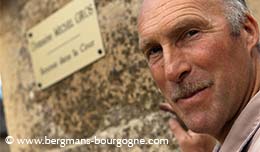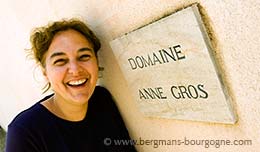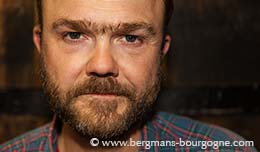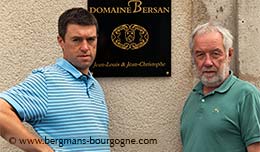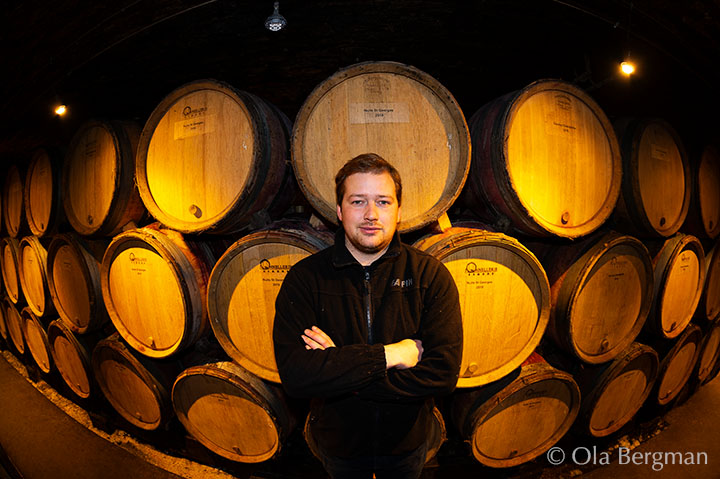
ver the past years Edouard Confuron in Vosne-Romanée has moved towards a much more vineyard specific approach. Instead of one single village appellation Vosne-Romanée cuvée, there are now three at Domaine Confuron-Gindre.
– I began separating our Vosne-Romanée parcels in 2017, he explains, because we have a total of 66 parcels. So all is set for creating small cuvées. I started with Les Hautes Maizières. In 2019 it was La Colombière. For the moment that’s it, according to my father. We don’t have room for more tanks in the winery.
Edouard Confuron is the sixth generation at the domaine. He carries a name which is tightly connected with wine and Burgundy. In Vosne-Romanée you also have Domaine Confuron-Cotetidot. In Premeaux-Prissey there is Domaine Jean-Jacques Confuron and in Vougeot you have Domaine Christian Confuron.
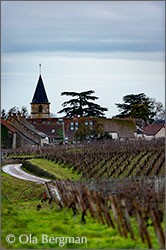 – The ancestor we have in common is Édouard Jayer, my great-great-grandfather, says Edouard Confuron. Over the generations his vineyards were split between his children, grandchildren etc. You know how it works in Burgundy. So now you have four Confuron domaines in the Côte de Nuits. That’s enough.
– The ancestor we have in common is Édouard Jayer, my great-great-grandfather, says Edouard Confuron. Over the generations his vineyards were split between his children, grandchildren etc. You know how it works in Burgundy. So now you have four Confuron domaines in the Côte de Nuits. That’s enough.
Domaine Confuron-Gindre covers 13 hectares. Most of it is in Vosne-Romanée, with a bit of Nuits-Saint-Georges and Gevrey-Chambertin thrown in for good measure.
– Our Gevrey-Chambertin is a blend from three different parcels – Les Crais, Les Seuvrées and Champs-Chenys. We have quite a lot of old vines at the domaine. In this case, for the Gevrey-Chambertin, the average age of the vines is between 50 and 60 years.
– Les Seuvrées is closer to Morey-Saint-Denis than Gevrey-Chambertin. Some say it’s not the best part of Gevrey-Chambertin. The soil is deep, and with old vines you get something which is very good and floral. Les Crais is a good parcel as well, but Les Seuvrées is older and delivers smaller quantities, with lots of concentration.
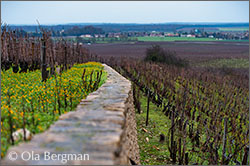 At Domaine Confuron-Gindre the wines are kept in barrels for 18 months. The cellar is cool, with very little variation in terms of temperature. As a result the malolactic fermentation starts later, usually in November. As it gets a bit colder it stops and then restarts in the spring. There is no fining or filtration.
At Domaine Confuron-Gindre the wines are kept in barrels for 18 months. The cellar is cool, with very little variation in terms of temperature. As a result the malolactic fermentation starts later, usually in November. As it gets a bit colder it stops and then restarts in the spring. There is no fining or filtration.
– For the three village appellation wines – Gevrey-Chambertin, Nuits-Saint-Georges and Vosne-Romanée – I use the same percentage of whole bunches. 2015 was a very hot summer, which can create very heavy wines. So in order to keep the acidity, to have some freshness, we decided to start using some whole bunches. 2015 turned out very well and we liked the style, so we decided to continue using whole bunches.
Depending on the vintage about 25 per cent new oak is used for the village appellation. As you move up to premier and grand crus more new oak is used, since wines with more structure are able to take it.
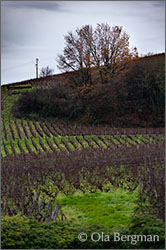 – Our three village appellation Vosne-Romanée cuvées are all made the same way, says Edouard Confuron. In the end it is the terroir which creates the difference.
– Our three village appellation Vosne-Romanée cuvées are all made the same way, says Edouard Confuron. In the end it is the terroir which creates the difference.
The basic Vosne-Romanée cuvée is a blend of grapes from Vigneaux, Le Pré de la Folie, Aux Communes (all three located between the village and the route nationale), Les Jacquines (on the Nuits-Saint-Georges side of the village), Aux Champs Perdrix (above La Tâche) and Les Rouges du Dessus. The last one is a premier cru just above Echézeaux, but since quantities are very small at the domaine it is not possible to make a separate cuvée from it.
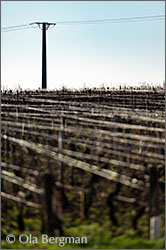 The Vosne-Romanée, Les Hautes Maizières, the first one to be singled out as a cuvée of its on at Domaine Confuron-Gindre, is a relatively rare wine in the sense that few growers have it as a separate bottling. According to Edouard Confuron only five or six do.
The Vosne-Romanée, Les Hautes Maizières, the first one to be singled out as a cuvée of its on at Domaine Confuron-Gindre, is a relatively rare wine in the sense that few growers have it as a separate bottling. According to Edouard Confuron only five or six do.
– Les Hautes Maizières is just below Les Suchots, he says. It’s a good terroir and it’s also a good stepping stone between village appellation and premier cru. It has more concentration than La Colombière, which is in the middle of the village. A long time ago La Colombière used to be the garden for the people living in Vosne-Romanée.
Les Hautes Maizières is higher up the slope, with stonier soil. While La Colombière is delicate Les Hautes Maizières is more expressive.
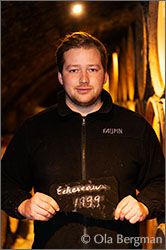 – La Colombière sees a bit more sun, says Edouard Confuron. The houses of the village protect it from the wind from the north. The wine is very floral in character. Roses. Fine and mineral at the finish. It’s very approachable when young.
– La Colombière sees a bit more sun, says Edouard Confuron. The houses of the village protect it from the wind from the north. The wine is very floral in character. Roses. Fine and mineral at the finish. It’s very approachable when young.
As mentioned, there will not be any new cuvées at Domaine Confuron-Gindre for the time being. But still. Edouard Confuron has his mind set on Aux Réas. So maybe, just maybe, in a few years time there will be one more village appellation Vosne-Romanée.
There are four premier crus at Domaine Confuron-Gindre, all in Vosne-Romanée – Les Chaumes, Les Brûlées, Les Beaumonts and Les Suchots. While you will find the last three up on the slope just northwest of the village Les Chaumes is squeezed in between La Tâche and Clos des Réas.
– We have 0.23 hectare in Les Chaumes, Edouard Confuron continues. This parcel was planted in 1918-1919. Some vines have died and have been replaced. So about 30 per cent are a hundred years old. We replant every year, so we have a good balance between young old vines. Sometimes you have vines with only one or two bunches. It’s not very good for the quantity, but for the quality it is. So we always tell our pickers at harvest not to forget the small bunches. They are very important for the quality. For Les Chaumes we use 20-25 per cent whole bunches and 50 per cent new oak.
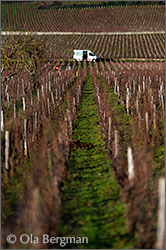 Les Beaumonts is a relatively young parcel. Planted in 1994 this is usually the place where harvest starts at Domaine Confuron-Gindre.
Les Beaumonts is a relatively young parcel. Planted in 1994 this is usually the place where harvest starts at Domaine Confuron-Gindre.
– We always have very good maturity here. The soil is not particularly stony, but I think the vines are a bit stressed, that there is not enough room for the roots. We just make three barrels of Les Beaumonts.
The road to Concœur cuts right through Les Brûlées. The parcel belonging to Domaine Confuron-Gindre is on your left as you are leaving Vosne-Romanée.
– Our parcel faces north, says Edouard Confuron. We are next to Cros Parantoux and Richebourg. The soil is brown and not as stony as on the other side.
Part of Les Suchots was recently returned to the domaine as a leasing arrangement coming to an end and more will come. The vines are old. Probably about 60 years, according to Edouard Confuron’s grandfather. It is in the lower part of Les Suchots, in Les Suchots du Bas.
Echézeaux is the only grand cru at Domaine Confuron-Gindre. It’s a blend from two parcels, the 50-year-old Les Treux and the 100-year-old Les Rouges du Bas.
– Les Treux is prone to frost, says Edouard Confuron. Les Rouges du Bas is very concentrated. The soil is like sand. Very nice soil. Les Treux is different. The soil there is deeper, not much stones. It’s like a hollow, with more water as a result. And the frost tends to stay there. The wine is 50 per cent from each parcel.
© 2021 Ola Bergman










